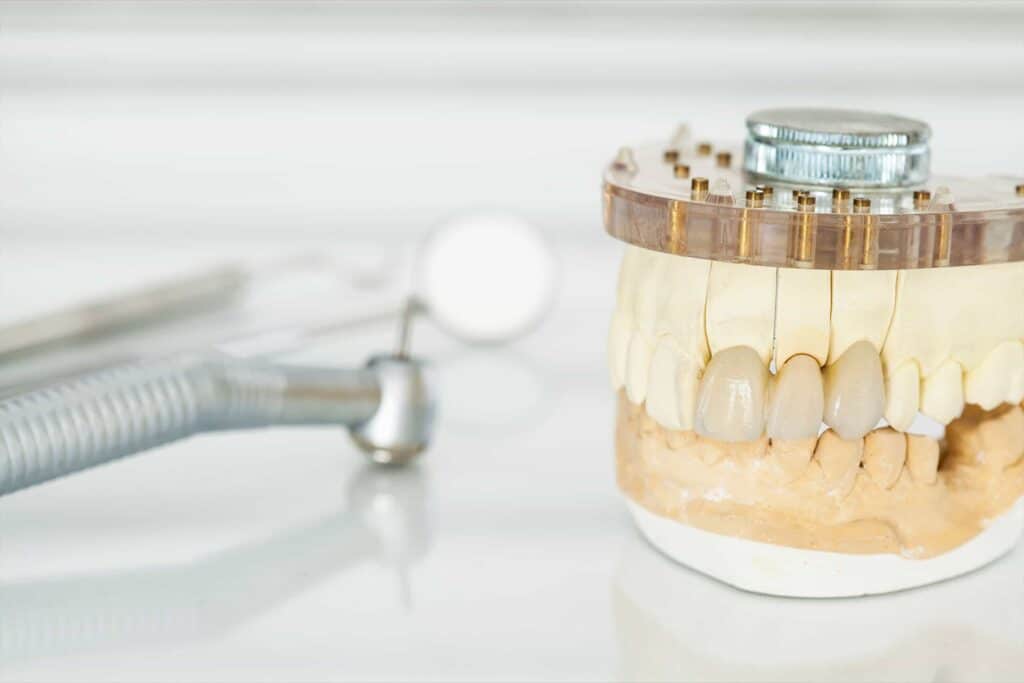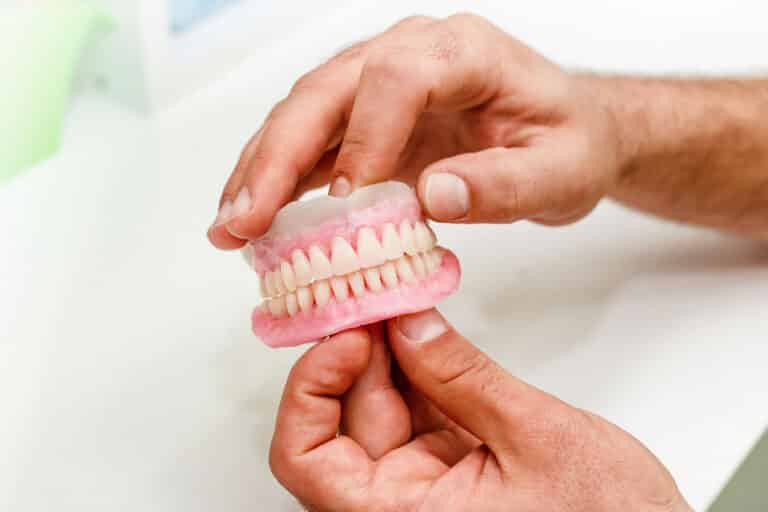Dental fillings are one of the most commonly completed restorative treatments, and is a workhorse that is rendered regularly. Fillings have many uses with the primary being replacing missing or lost tooth structure due to various causes. Most people who have had any restorative treatment have had a filling or two. While fillings are an extremely versatile treatment, they have limitations and cannot replace other treatment options such as implants or dentures.
What are Dental Fillings
Dental fillings are synthetic material that is placed directly into or inside a prepared tooth that replaces tooth structure that is lost due to trauma or disease. There are several types of dental filling materials including compositeA synthetic resin that is used for while fillings. This is what most people receive when they get fillings. resin fillings, dental silver amalgam fillings, glass ionomers fillings, and gold fillings. Today the most common material is composite resin, also known as white or tooth-colored fillings.
As the first-line defense in treating small to moderately-sized caries or tooth decay, dental fillings are a common way to fix a minor cavity or broken tooth. Tooth fillings easily and quickly replace what was lost to restore the tooth back to health. Additionally, dental fillings have other uses as well such as attachments in orthodontic treatment or as a veneer material.
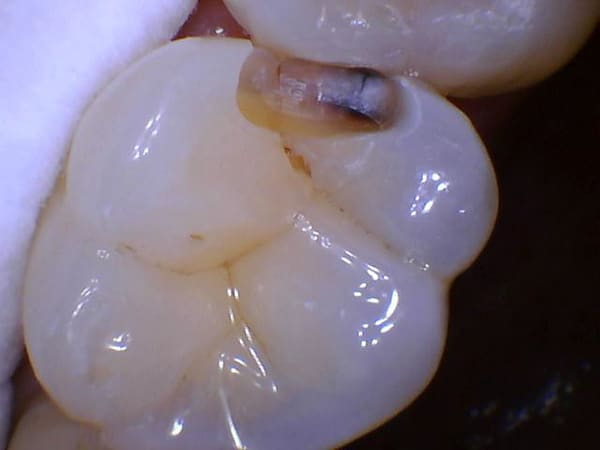
Dental fillings are known as direct restorations, meaning they are placed and finalized inside the mouth as opposed to indirect restorations such as crowns, which are fabricated outside the mouth in a lab.
What are the Advantages and Disadvantages of Fillings
There are many uses for tooth filling and even pros and cons between the different filling materials. They are best when used as indicated and should be avoided when there are better treatment options.
Advantages of Dental Fillings
There are many uses for tooth filling and even pros and cons between the different filling materials. They are best when used as indicated and should be avoided when there are better treatment options.
- Simplicity – Fillings are a straightforward procedure that is completed in a single dental visit.
- Speed – Dental fillings are some of the quickest procedures to complete, with some fillings taking as little as a few minutes to complete from start to finish. Other treatment options often require more time, up to weeks or even months, to complete.
- Cost – Due to their simplicity and speed, fillings are an extremely cost-effective option to treating dental diseases. Additionally, dental insurance will typically cover a large percentage of fillings.
- Versatility – There are many uses for dental fillings which include:
- Restoring lost tooth structure lost due to trauma or disease.
- Improving esthetics and food impactionWhen food gets stuck in between teeth. This causes irritation in the gums and can be very uncomfortable. by closing gaps between teeth or improving the shape of the tooth via veneers.
- Sealing off the access hole to prevent food impaction in implant crowns or after a root canal procedure.
- Improving the mechanical retention of dental crowns via core buildups.
- As attachments for clear aligner orthodontic treatment.
- Good Esthetics – Composite resin materials are very esthetic and are capable of blending into existing dentition. The high polishability makes it difficult for many people to distinguish between a filling and natural teeth.
Disdvantages
While fillings are versatile, their limitations include:
- Longevity – Traditional fillings are not expected to last as long as other treatment options such as crowns, partial crowns, or implants. Many composite fillings wear down at a faster rate than natural teeth, although there are types of filling materials that are designed to counteract teeth with increased wear.
- Increased Staining – Fillings will stain over time. While the staining is different between the types of filling, they do stain and discolor over time.
- Shrinkage – The physical properties of composite fillings result in shrinkage when cured1. This leads to potential issues such as marginal failure, staining, and post-operative sensitivity for example. This is less of an issue with dental amalgamA mercury metal alloy that is used to replace missing tooth structure. Also known as metal, silver, or mercury fillings, they are widely used in dentistry due to it’s physical properties, cost, and ease of use. Although multitudes of studies have shown amalgam to be safe, concerns regarding toxicity and environmental factors have shifted towards the use of dental composite. fillings.
- Less protection – Fillings don’t provide as much protection against biting forces when compared to full coverage restorations such as crowns. They are also not as strong when compared to other dental materials such as ceramics.
What are the Different Types of Dental Fillings
Practically speaking, there are two types of dental fillings: white and metal. Dental amalgam fillings are known by many names including silver fillings, silver amalgam fillings, mercury fillings, and metal fillings. On the other hand, white or tooth-colored fillings are composed of multiple materials and different variations of that same material.
For example, the composition of tooth-colored fillings on a posterior tooth is typically different from an anterior tooth even though they are both made of a synthetic resin. In short anterior composite resin material is more polishable and esthetic than posterior composite resin. Posterior composite resin fillings are not unesthetic by any means, but strength is favored over esthetics since the tooth-colored composite doesn’t have to perfectly match in back teeth.
Additionally, there are white fillings that are made of a different material such as glass ionomer. These different materials have different physical properties and are indicated for different situations.
While most people don’t immediately think of gold fillings, they are used to great effect. Gold fillings, also known as an inlay, is an indirect restorationA synthetic material, typically a porcelain, titanium alloy, or gold alloy, that is made and formed outside a patient’s mouth. that does not cover a cusp as opposed to onlays which are also called partial crowns. When properly done, cast gold fillings can last many decades.
Gold inlays have fantastic marginal adaptation and closely replicate the natural tooth in an unaltered state. However many people generally do not opt for indirect fillings due to increased time and cost.
What are White Fillings Made of?
When most people are referring to white fillings, they are speaking of composite fillings which are made up of synthetic resin. This is the most common type of white filling that is done. Amongst composite fillings, there are also varying compositions, referring to how ‘filled’ each resin type is. Depending on the filling material, varying-sized particles make up the resin. This allows for varying degrees of physical properties including polishability, strength, wear, and esthetics2https://meridian.allenpress.com/operative-dentistry/article/34/5/551/107012/Nanohybrid-Resin-Composites-Nanofiller-Loaded.
Additionally, there are other materials such as glass ionomer and ceramic fillings. While still tooth colored, they all have different properties. Glass ionomer tends to be weaker than both resin and ceramics however, they are more resistant to tooth decay since it releases fluoride3https://www.sciencedirect.com/science/article/abs/pii/S0142961297001300. Depending on the situation, each type of white filling material should be used to repair tooth damage.
What are Amalgam Fillings Made Out of?
Dental amalgam fillings, also known as silver amalgam, silver filling, or mercury fillings, are composed of several different metals including silver, tin, cooper, indium, palladium, zinc, and mercury9https://www.ncbi.nlm.nih.gov/pmc/articles/PMC3010024/10https://journals.sagepub.com/doi/full/10.1177/09603271221106341. HHaving been used for many decades, silver fillings are considered to be an extremely useful material due to their studied longevity and strength. However, in the past couple of decades, silver fillings are becoming less and less common due to health and esthetic concerns.
Prior to significant improvements to dental composite materials, dental amalgam fillings were a workhorse due to their strength and ability to ‘seal’ the gap between the restorationA synthetic material that replaces either part or the whole tooth that is missing due to disease or trauma. and tooth via a corrosion process11https://meridian.allenpress.com/operative-dentistry/article/34/3/312/107440/Corrosion-Sealing-of-Amalgam-Restorations-In-Vitro.
Additionally, dental amalgam restorations are not as technique sensitive as composite. This means that it is easier for dentists to successfully place a dental amalgam vs a composite material since it isn’t as critical to have a moisture-free environment with dental amalgam fillings.
Perhaps the biggest fear and controversy surrounding silver fillings is the fact mercury is used. When used to repair teeth, mercury mixed with the other metals is what eventually becomes an amalgam filling. Once fully set, many studies show that the silver amalgam filling material is dimensionally stable with no leakage. However, for those with an amalgam allergy or preference to not us anything that uses mercury, there are good options today.
As composite technology improved, many of the initial weaknesses improved which made them a more appealing option. Compounded with health concerns due to mercury exposure10https://journals.sagepub.com/doi/full/10.1177/09603271221106341, esthetic concerns of stained and blackened teeth, and the rise of improved alternative materials, dental amalgams are less frequent and may eventually disappear entirely from practiced dentistry.
What Happens When I Get a Filling?
Once tooth decay has been diagnosed and the proper treatment is a dental filling, the following is what the treatment can be boiled down to: the diseased part of the tooth is removed and what was removed is replaced with a synthetic material. Here’s some more details about this common procedure:
- The tooth and surrounding gums are anesthetized with a local anesthetic.
- The diseased part of the tooth is removed using a laser or various burs. During this time, the patient will feel water, pressure, and vibrations. They will hear the whir of the drill as well. However, there should be no sharp pain.
- The tooth is then properly shaped, ensuring sound tooth structure remains. Unsupported tooth enamelThe outermost layer of a tooth. Highly mineralized and resistant to decay. must be removed as it is very weak and prone to breaking off. If this were to happen, it would make the filling at increased risk of further tooth decay due to a compromised marginThe interface between a restoration and the tooth. This is the most common area for a cavity to reoccur on a tooth.. The shaping of the tooth will vary depending on the type of filling and the extent of tooth decay. For instance, dental amalgam fillings require mechanical retention due to the lack of bonding and thus require more aggressive undercuts to ensure they do not fall out.
- The tooth is then isolated from the rest of the mouth using either a rubber damA square piece of rubber, typically containing latex, that has a small hole which one or more teeth pass through. It isolates the tooth and acts as a barrier from the rest of the mouth and is used for many dental procedures, especially root canals. There are non-latex versions available for those allergic to latex. or a combination of cotton and isolation equipment. This is very important, especially for composite restorations, as moisture will interfere with the bonding process. Poorly done fillings increase the risk of premature decay.
- If a new interproximal contact must be re-established, some sort of a filling shaping system is used. This occurs when the affected tooth is next to existing teeth. Two very common systems are the tofflemire system and various ring systems. The point of these systems is to create an enclosed ‘box’ that closely mimics the tooth’s natural shape. Additionally a small wedge is placed to block out any filling materials from being extruded apically towards the gum. This prevents overhangs which will accumulate a lot of bacteria and cause issues including further decay.
- For tooth colored composite fillings: the tooth is etched either fully or partially with acid, typically phosphoric acid. This helps to increase the bonding to the tooth and removes the smear layer. The tooth is then primed and a bonding agent is placed and cured. Uncured composite resin is then injected into the mold, sometimes incrementally or in bulk, again depending on the type of composite. It is then shaped using various instruments to get a close approximate shape of the tooth and then cured. This is where you would see a bright blue light, which is not an ultraviolet (UV) light. While UV lights were used historically, LED lights are used today.
- For dental amalgam fillings: Once the tooth is properly isolated, the dental amalgam capsule is mixed. Then the material is deposited into the tooth in small increments and condensed using various hand instruments. Excess bits of the dental amalgam restoration is suctioned away and the newly filled tooth is ready to be shaped.
- Regardless of the material type, the excess restorative material is cleaned, shaped, and polished. Using various hand instruments and finishing burs, the excess material is polished, contoured, and removed. Simply put, the tooth is made to look, feel and function like a tooth once again. The bite is then checked and then the filling is polished. Dental amalgam fillings are initially weak and vulnerable for up to a week while it fully sets and cannot be polished until a later date.
How Long do Fillings Last?
Fillings are an effective restoration type and the longevity of dental fillings will depend on many factors. A good rule of thumb is they should last approximately 7-10 years4https://www.sciencedirect.com/science/article/abs/pii/S03005712150010865https://www.sciencedirect.com/science/article/abs/pii/S01095641110083116https://www.sciencedirect.com/science/article/abs/pii/S0109564105003507. The primary reasons for failure are recurrent cariesDental caries that reoccurs at the margin of an existing restoration., fracture and endodontic treatment7https://link.springer.com/article/10.1007/s00784-003-0206-7. Indirect fillings tend to last longer as well as there is no shrinkage of the material which results in a more seamless tooth to dental material interface.
While it is true that fillings can last longer, sometimes multiple decades, the opposite is also true. Fillings have been observed to fail within a few years as well. Below are a few factors that can affect the longevity of dental fillings.
What Makes Dental Fillings Last Longer?
While there are many factors that are out of one’s control, there are many things that anyone can do to get the most longevity out of their fillings as possible.
Dental Hygiene
Although seemingly obvious, there are some people who are more cavity prone and require additional hygiene tips and tricks. Just like how a car or house will fail faster if not regularly maintained, any restorative dental work will prematurely fail if not maintained.
The Size of the Cavity Filling
If the filling is small, the remainder of the tooth is strong and able to withstand more cycles of chewing. Single surface fillings such as a small occlusalThe ‘top’ of teeth where chewing occurs on posterior teeth. This surface has pits and grooves. or buccalThe same surface as ‘facial’ but technically only on posterior teeth. filling generally will last longer than a filling that covers 80% of the biting surface.
The Extent of Decay
After treatment, the tooth must be decay free as not removing all the diseased tooth is poor practice. If the decay is unexpectedly large or deep, there may not be enough tooth structure for a proper filling. When the decay is close to the dental pulpThe nerve tissue of the tooth., the dentist may opt to place a temporary filling and come back later for the definitive treatment which includes a crown and/or root canal procedure.
The Skill of the Dentist
Resin composite fillings are more technique sensitive than dental amalgam restorations. If there is improper cavity preparation or the filling isn’t correctly placed, a replacement filling will be needed to fix the first filling. This is more common with tooth colored composite resin as the material is more difficult than silver amalgam fillings.
The Best Dental Material
Even amongst tooth colored material, the correct type must be used in each situation. As a general rule of thumb, anterior teeth are better to bite and tear whereas the posterior grind food into smaller sized particles.
Due to this, posterior fillings need to be stronger and don’t have high esthetic requirements whereas anterior teeth are the opposite. If a weaker filling material is placed in the back teeth, it will wear down faster and need to be replaced faster.
What makes dental fillings fail faster?
There are many factors that play a role in the longevity of fillings. Trying to control as many of these as possible will eke out as much life as possible out of your fillings.
Acute and/or Chronic Trauma
Acute trauma, such as getting hit in the face by a rogue baseball, obviously results in broken teeth. Less obvious is bruxism and bad habits. Bruxism or tooth grinding puts a high amount of stress on the filling and surrounding tooth structure. Repeated excessive biting forces, even on healthy teeth, will eventually cause something to chip or break, resulting in emergency dental treatment.
The Size of the Filling
A large and complex filling that covers multiple surfaces, including cusps means the underlying tooth is compromised. Simply put, as the size of the filling gets bigger, the remaining tooth gets smaller and subsequently weaker. Unfortunately in many instances, large amounts of teeth are damaged by trauma or disease, necessitating large fillings and dental crowns.
Location of the Filling
Many cavities occur in hard to reach areas, making them harder to keep clean. This often leads to the cavity forming in the first place. If the area is not easily cleansable, it will be at a higher risk of more cavities.
An incredibly common location for a cavity to reoccur on a tooth is at the interface of the restoration and tooth. If a filling extends under the gums and is hard to clean, it will require more attention to ensure maximum longevity.
Hygiene and Diet
Most people generally understand that good diet and hygiene result in better oral health, especially those with a compromised medical or family history. Frequently eating sweet foods and improperly cleaning your teeth will result in a shorter lifespan of your fillings.
What Can Dental Fillings be Used for?
As previously mentioned, fillings are incredibly versatile. They have many uses, both functionally and esthetically. Their purpose, like many dental restorations, is to replace or add tooth structure to restore function and improve esthetics.
Functional Uses for Fillings
One of the most common uses for fillings is as a way to replace diseased teeth. Dental cariesMost commonly known as a tooth cavity, dental caries refers to decay and rot of the tooth. The breakdown of the enamel and/or dentin is caused by oral bacteria leaving acid on the teeth as a by-product of food consumption. Dental caries is referred to by various names including cavities, tooth rot, and decay. is one of the most common diseases in the US, with 90% of adults over the age of 20 currently having a history of dental decay8https://www.ncbi.nlm.nih.gov/pmc/articles/PMC6373711/. For small to moderate sized fillings, the best and most conservative approach is to do some type of dental filling. This approach removes the decay, appropriately shapes the tooth, following the biomechanical rules, and replaces what was taken away with a synthetic material.
Composite or amalgam is also frequently used as a buildup or as the “core” in a post and coreA small thin metal or fiber rod that is glued in the canal of a root canaled tooth. Its main purpose is to retain the core, which is a filling under a crown. procedure. Both serve the same purpose, which is to create an ideal retention and resistance form under a dental crown. The difference is that a post and core is only utilized in root-canaled teeth. In either case, the filling material is critical to the success of compromised teeth.
Essentially dental crowns need something to grab onto, a concept called resistance form. Part of what a dental crown grabs onto must be the natural tooth, but part of it can either be direct or indirect fillings.
As previously mentioned, dental fillings are the treatment of choice for small to moderate fillings. However, although not ideal, they can be used for larger fillings as well. This isn’t the ideal way to utilize fillings as the treatment of choice for teeth with large fillings is crowns.
Since it isn’t feasible for some people to immediately get crowns, stabilizing the tooth with a large filling is better than no treatment. It should be stressed to the patient that it’s essentially a temporary filling until either a ceramic or gold crown, typically fabricated by a dental laboratory, can be made for the tooth.
Composite can also be used to splint mobile teeth due to periodontal disease. The most common area to do this is on the lower anterior teeth. By splinting loose teeth to non-mobile teeth, it stabilizes the mobile teeth which can increase longevity. However, there cannot be any active periodontal disease and this is not the treatment of choice for most patients. Typically this is done for elderly patients who cannot tolerate surgery or prosthetics to replace the mobile teeth should they be extracted.
Dental composite can also be used to splint teeth due to trauma. After receiving acute trauma to the upper and/or lower jaws, teeth may be fully or partially avulsed out of the socket. When this happens, the teeth must be stabilized to allow healing and any follow-up treatment.
Dental filling material is also used in orthodontics as well. Primarily used in clear aligner therapy, there are small various shapes on teeth called attachments. Attachments allow the aligners to direct forces in specific directions to create very specific movements of the teeth. It can also be used when teeth become excessively mobile during orthodontic treatment, which is a potential complication.
Esthetic Uses for Fillings
Another common use for fillings is as a way to improve esthetics. When teeth are present but malaligned, misshapen, severely discolored, or otherwise unappealing, dental composites are an excellent way to quickly improve the appearance. Additionally, depending on what is being corrected, composites can be an extremely effective and conservative option.
For instance, a form of microdontia called peg laterals is a common malformation of the maxillary lateral incisors. As this does not follow the golden ratio and is unesthetic, they require one or more interventions of esthetic dentistry to idealize the smile. By adding and contouring composite onto the malformed incisors, the appearance can be greatly improved often without the removal of any part of the tooth.
The primary objective of esthetic uses of dental composites aims to idealize the appearance of the teeth. There are many deviations from the ideal that people are trying to fix which include:
- Spacing between teeth.
- Various types of size discrepancies such as microdontia.
- Rotated teeth – keep in mind that adding composite to rotated teeth may compromise the hygiene and/or increase plaque accumulation.
- Discolored teeth – this should be a secondary option to bleaching treatment which can be much more effective.
- Worn/fractured teeth – this may not be a viable option depending on the occlusion and the etiologyThe reason why a disease or condition occurs. An example is the etiology of a fractured tooth is from when someone fell down and traumatized the tooth. of the wear or fracture. For example, if the patient has severely worn teeth due to bruxism it is likely they will fracture the composite veneers.
- Missing teeth – although an option, using composite for this purpose is extremely unpredictable and may not last very long. Using dental composite to replace teeth is not the treatment of choice. Typically implant or bridge therapy is going to be superior.
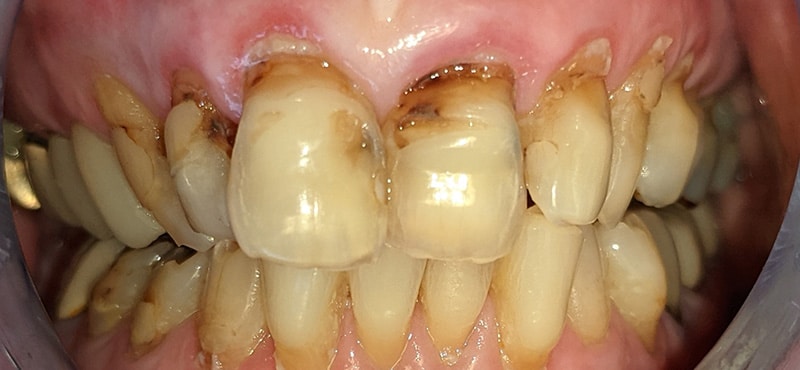
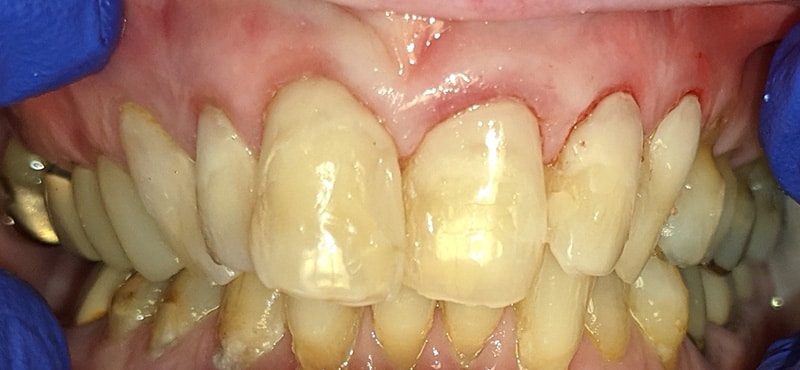
What are the Biggest Limitations of Fillings?
While dental fillings are extremely versatile, they are not an end-all be-all material. The limitations are due to the properties of the various filling materials themselves. Fillings make teeth healthier but weaker. Repairing any pathology will make the teeth significantly healthier but in doing so, there is less of the natural tooth structure remaining.
Once the tooth integrity starts to become compromised and the risk of fracture increases, fillings are insufficient to protect the teeth. Crowns then become the treatment of choice to protect the tooth from further damage.
There are other limitations which include:
- Stains quicker over time as compared to other restorations.
- Can stain tooth structure, leading to a darker looking tooth. This typically applies to amalgam fillings only.
- Tends to fracture more frequently than crowns
- Polymerization shrinkage increases the difficulty of proper placement of composites. If not properly done, fillings can lead to significant post-operative sensitivity.
Why Can’t I get a Bigger Filling Instead of a Crown?
The primary reason fillings cannot be used in place of crowns has to do with the inherent limitations of fillings as previously mentioned. Fillings are very good at replacing small to moderately damaged teeth however as the amount of tooth structure gets larger, the weaker the tooth becomes. Dental filling material is not a predictable way to protect weak teeth.
Although there are some exaggerations, imagine a solid chunk of wood vs another chunk of wood the same size but has 50% of the total volume replaced by weaker balsa wood due to termites. Although both are termite free, the repaired wood is much weaker and is much more likely to fracture if placed under stress.
However this does not mean that there is no place for large fillings where crowns should be used. As previously mentioned, fillings make teeth healthier but weaker. When a tooth is severely decayed or fractured and there is limited time or money to get the ideal treatment, large fillings can be used as a stopgap until the ideal treatment can be rendered. Again these are temporary fillings that need to be replaced with dental crowns.
This is more common during the caries control phase when the patient doesn’t have enough time or money to get dental crowns. This strategy makes the teeth healthier and buys time for the patient by stopping the progression of the disease. If no action were to be taken, dental caries would compromise too much tooth structure to predictably save the tooth.
Does Dental Insurance Cover Fillings?
Most likely there will be some insurance coverage for dental fillings. As one of the most commonly completed dental treatments, dental insurance will cover a fair portion of the cost. Many dental insurances consider fillings a minor procedure and have coverage however, keep in mind that not all dental insurances are the same and there are some that have no coverage for restorative procedures. If you have any questions about your coverage and out-of-pocket costs, contact your insurance company or dental office for more information.
Was this post helpful?
Table of Contents
- What are Dental Fillings
- What are the Different Types of Dental Fillings
- What Happens When I Get a Filling?
- How Long do Fillings Last?
- What Can Dental Fillings be Used for?
- What are the Biggest Limitations of Fillings?
- Why Can’t I get a Bigger Filling Instead of a Crown?
- Does Dental Insurance Cover Fillings?
References
- 2
- 3
- 9
- 10
- 11
- 4
- 5
- 6
- 7
- 8


